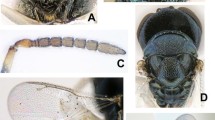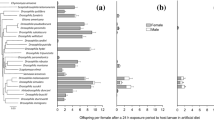Abstract
Lydina polidoides (Townsend) andChrysoteuchia topiaria Zeller were studied in the laboratory. The rate of development ofC. topiaria from eclosion to the diapausing prepupae was 55 days when larvae were exposed to long daylenghts (16 hr light, 8 hr dark) and 43 days when exposed to short daylengths (12 hr light 12 hr dark.) The same insects exposed to long days emerged as adults in 124 days, whereas those exposed to short days emerged in 156 days because short days prepared the prepupae for diapause but failed to maintain the diapause. When caterpillars (prepupae) ofC. topiaria parasitized by young larvae ofL. polidoides and non-parasitized caterpillars were removed from the field in January and exposed to long days at 21°C,C. topiaria emerged as adults in an average 55 days andL. polidoides in 106 days.Lydina polidoides is therefore univoltine andC. topiaria is probably the primary host of this Tachinid parasite.
Résumé
Lydina polidoides (Townsend) etChrysoteuchia topiaria Zeller ont été étudiés en laboratoire. La durée du développement deC. topiaria depuis l'éclosion jusqu'à la prénymphe en diapause est de 55 jours lorsque les larves sont soumises à des jours longs (16 heures d'éclairement, 8 heures d'obscurité) et de 43 jours quand elles sont élevées en jours courts (12 heures d'éclairement, 12 heures d'obscurité). La sortie des adultes se produit au bout de 124 jours en jours longs et en 156 jours en jours courts, parce que les jours courts induisent la diapause chez les prénymphes mais ne permettent pas le maintien de cette diapause. Lorsque des chenilles (prénymphes) deC.topiaria parasitées par de jeunes larves deL. polidoides et des chenilles non parasitées sont prélevées dans la nature en janvier et sont exposées à des jours longs à 21°C,C. topiaria donne des adultes en 55 jours en moyenne etL. polidoides en 106 jours.Lydina polidoides est donc univoltin etC. topiaria est vraisemblablement l'hôte primaire de ce tachinaire parasite.
Similar content being viewed by others
References
Banerjee, A. C.—1967. Sod webworm parasites in Illinois.—J. econ. Ent.,60, 1173–74.
Bohart, R. M.—1947. Sod webworms and other lawn pests in California.—Hilgardia,17, 267–307.
Clausen, C. P.—1940. Entomophagous Insects.—McGraw-Hill, New York and London.
Franklin, H. J.—1950. Cranberry insects in Massachusetts. Part III. Insects attacking the stem.—Mass. agric. Exp. Stn. Bull.,445, 19–35.
Kamm, J. A.—1970. Effects of photoperiod and temperature onCrambus trisectus andCrambus leachellus cypridalis. —Ann. ent. Soc. Am.,63, 412–16.
— — 1971. Environmental biology of a sod webwormCrambus tutillus [Lepidoptera: Crambidae]. —Ent. exp. appl.,14, 30–38.
— — 1973. Biotic factors that affect sod webworms in grass seed fields in Oregon. —Environ. Ent.,2, 94–96.
Author information
Authors and Affiliations
Additional information
Work conducted in cooperation with the Oregon Agricultural Experiment Station, Corvallis, and approved as Technical Paper No. 3415.
Rights and permissions
About this article
Cite this article
Kamm, J.A. Development ofLydina polidoides [Diptera: Tachinidae] in relation to its hostChrysoteuchia topiaria [Lepidoptera: Pyralidae] . Entomophaga 18, 223–227 (1973). https://doi.org/10.1007/BF02371469
Issue Date:
DOI: https://doi.org/10.1007/BF02371469




